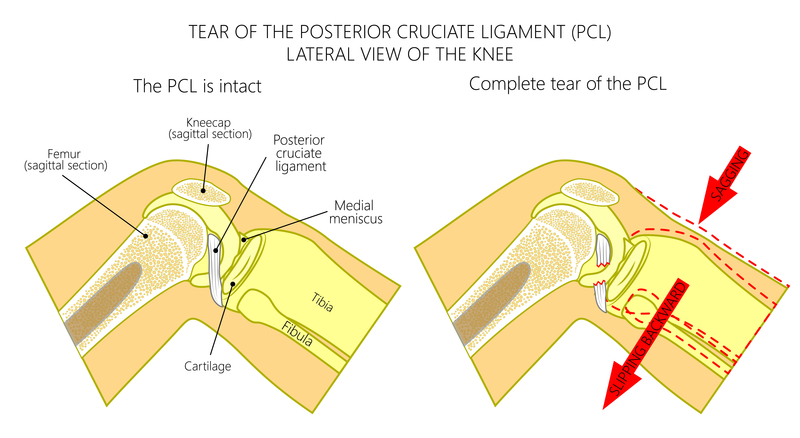What Is a Torn PCL?
The posterior cruciate ligament is strong, tough, and has the remarkable ability to heal itself following an injury. Even a torn PCL seldom requires surgery.
When it comes to knee injuries, we often hear of tears or sprains of the ACL (anterior cruciate ligament), MCL (medial collateral ligament), or LCL (lateral collateral ligament). There’s also the sprained or torn PCL—the posterior cruciate ligament. In fact, the biggest and strongest of the four ligaments in the knee is not the more famous ACL—it’s the PCL.
The posterior cruciate ligament’s name tells us what it is: “posterior” because it’s behind the ACL; “cruciate” because it forms an X with the ACL; and “ligament” because it’s a tough, flexible tissue that connects two bones. In this case, the two bones are the femur (thigh bone) and the tibia (one of the two bones in the lower leg). The PCL is the primary stabilizer of the knee.
Torn PCL Injury: How It Happens
A torn PCL happens when the knee or upper leg takes a severe blow—as in a car wreck, when a person’s bent knees are slammed against the dashboard. A torn PCL could also result from a direct blow to the area just below the knee or a fall in sports like football, soccer, baseball, or skiing. The injury also can be caused by a simple misstep.
Any time the knee is hyper-flexed (bent) or hyper-extended (straightened), the possibility of a torn PCL is present. Fortunately, PCL tears account for less than 20 percent of injuries to the knee.
When a tear does occur, it could be an isolated injury, but it’s more likely to be one that involves other ligaments, as well as the meniscus or the surface of bones in the knee.
Torn PCL Symptoms Start with Pain and Swelling
Unlike torn ACLs, the person who suffers a PCL tear does not hear a popping sound. The symptoms are pain (possibly in the back of the knee); a limp or difficulty in putting weight on the knee; swelling that occurs quickly because of internal bleeding; and a sense that the unstable knee may buckle. Instability may be a symptom of a PCL injury that occurred months or years before getting a diagnosis from a doctor.
Some people with a torn PCL may not seek medical attention at all. If they’re lucky, the PCL heals itself. If not, instability later on may be a sign that it’s time to get medical attention.
PRICE Is the Immediate Treatment
Immediate treatment for a torn PCL is similar to that of any acute joint injury. Remember the acronym “PRICE”:
- Protection
- Rest
- Ice
- Compression
- Elevation
If pain persists more than a few days, it’s important to see a physician.
The doctor will ask how the injury occurred, conduct physical tests to determine the knee’s stability and strength, and probably order x-rays and a MRI. X-rays show whether bone damage has occurred. MRIs produce images of soft tissue damage and determine the exact location of the injury. They have been demonstrated to be near 100 percent accurate in diagnosing PCL injuries.
Torn PCL Grades
PCL tears are classified according to grades established by the American Academy of Orthopaedic Surgeons.
- Grade 1: Mild damage; ligament slightly stretched, but stable
- Grade 2: A partial tear; ligament stretched to be point of being loose
- Grade 3: Complete tear of the PCL ligament into two pieces; unstable joint
Isolated PCL Tears Seldom Require Surgery
If a torn PCL is an isolated injury, it seldom requires surgery. You can recover with crutches (at first) to limit pain; with rehabilitation exercises to strengthen the quadriceps and hamstring muscles; and with a knee brace designed specifically for a PCL injury (not a simple compression sleeve available at a retail store or pharmacy).
If a PCL tear is combined with other knee damage, surgery is almost always recommended. A completely torn PCL has to be rebuilt using a graft of tissue from your own body or from a human donor (cadaver).
Recovery from non-surgical treatment takes about six to eight weeks, and you can return not only to normal activities but to sports activities as well.
After PCL reconstruction, you’ll need six to 12 months for recovery. Elite and recreational athletes may be advised to wear a knee brace or modify their physical activities.
Good News, Bad News, Good News
The posterior cruciate ligament is strong and not likely to tear. If it happens, it will probably heal by itself or with physical therapy, and without surgery. Even when surgery is necessary, a well-designed rehabilitation program will allow you to return to your normal lifestyle.
For related reading, visit these posts:
- Knee Pain Remedies: Start with Classic “RICE” Advice
- Knee Replacement Alternatives vs. Knee Surgery: Explore Your Options for Osteoarthritis
- Baker’s Cysts Can Cause Pain Behind the Knee
- Knee Joint Pain Solutions, from Strengthening Exercises to Surgery to Alternative Treatments
- Pain Behind Knee? Injury vs. Disease-Related Causes
- Bursitis: Knee Pain Could Be Rooted in Inflammation of Knee



 Bone Spurs on the Spine
Bone Spurs on the Spine  Knee Injections for Osteoarthritis Pain Relief
Knee Injections for Osteoarthritis Pain Relief  What Is a Slipped Rib?
What Is a Slipped Rib? 
In some instances, a torn PCL can heal on its own.
Bannasak | Dreamstime.com